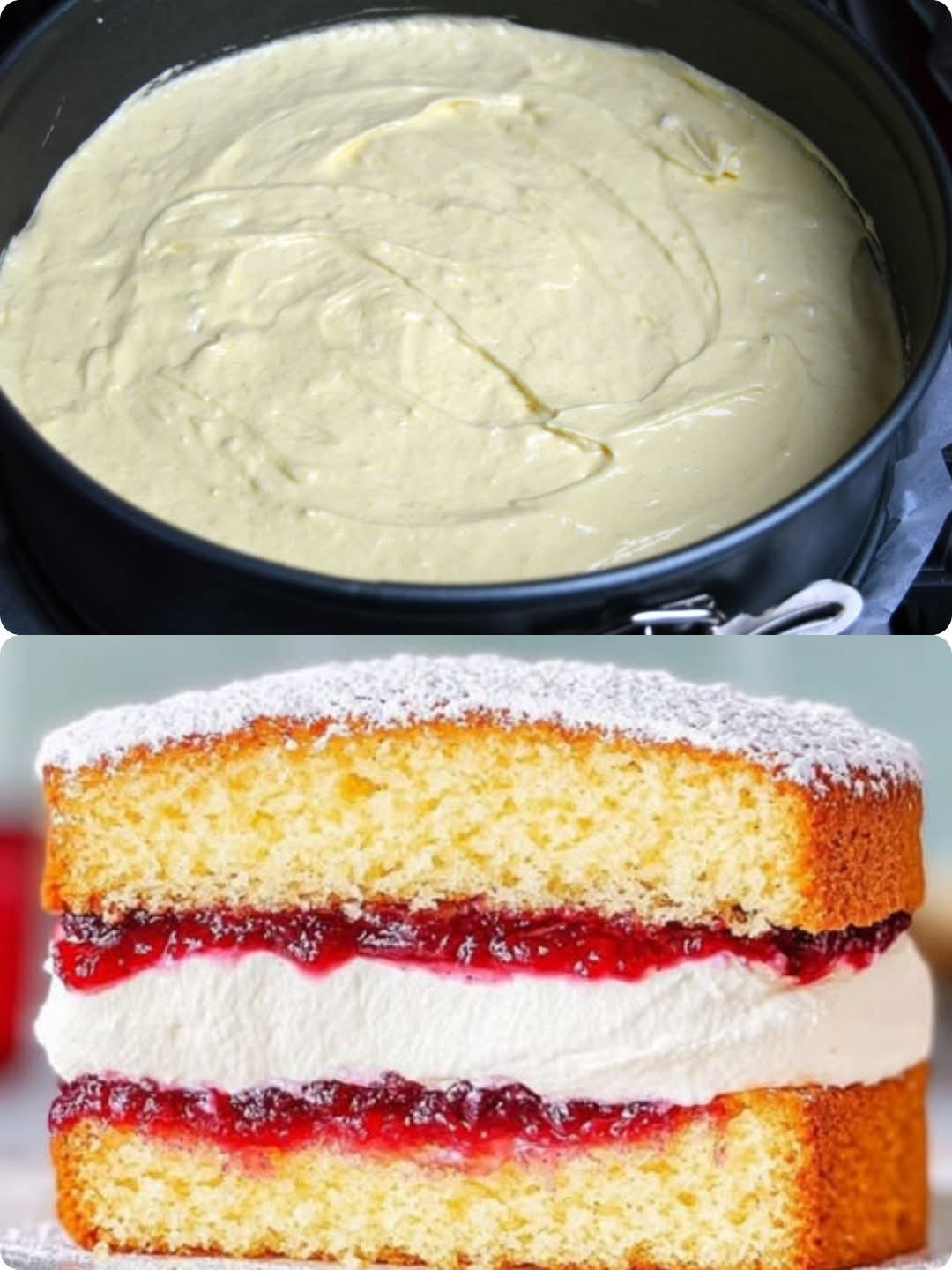Sure! Here’s a complete, beautifully expanded version of the Victoria Sandwich Cake recipe including its history, ingredients, instructions, benefits, formation, nutrition, conclusion, and thoughts from those who love it. Enjoy this full culinary journey into a beloved British classic.
🎂 Victoria Sandwich Cake – A Royal Classic
👑 Introduction
The Victoria Sandwich Cake—also known as the Victoria Sponge—is a quintessential British teatime treat. This elegant cake is named after Queen Victoria, who famously enjoyed a slice with her afternoon tea. With its soft, airy sponge and sweet jam-and-cream filling, the Victoria Sandwich is a testament to simplicity and perfection. Whether served at a garden party, a family gathering, or enjoyed quietly with a cup of Earl Grey, this cake is a symbol of timeless baking.
📜 History of Victoria Sandwich Cake
The cake dates back to the 19th century during the reign of Queen Victoria (1837–1901). Afternoon tea had become a fashionable ritual, and light cakes were preferred. The Victoria Sponge emerged as a favorite because of its delicate crumb and elegant presentation. Traditionally filled with raspberry jam and sometimes whipped cream, it was served as a refined alternative to richer fruitcakes and puddings.
The term “sandwich” refers to the method of layering—two sponge cakes “sandwiching” a filling. Over time, this cake became a staple in British households and remains one of the most loved cakes in the UK and around the world.
🧾 Ingredients
Make sure all ingredients are at room temperature for the best results.
For the Sponge:
- 225g self-raising flour
- 2 tsp baking powder
- 225g unsalted butter, softened
- 225g caster sugar
- 4 large eggs, lightly beaten
- 1 tsp vanilla extract (optional, for extra flavor)
For the Filling:
- 100g raspberry or strawberry jam (use a good-quality preserve)
- 150ml double cream or whipped cream (optional)
For Decoration:
- Icing sugar, for dusting
🧑🍳 Instructions & Method
Step 1: Preheat and Prepare
- Preheat your oven to 180°C (350°F) or 160°C fan.
- Grease and line two 8-inch (20cm) round cake tins with parchment paper.
Step 2: Cream Butter and Sugar
- In a large mixing bowl, cream together the butter and sugar until pale, light, and fluffy. Use a stand mixer or hand mixer for best results (about 3–5 minutes).
Step 3: Add Eggs
- Gradually add the beaten eggs one at a time, mixing well after each addition. If the mixture starts to curdle, add a tablespoon of the flour.
Step 4: Sift and Fold
- Sift together the flour and baking powder, then gently fold it into the batter using a spatula or metal spoon. Be careful not to overmix.
Step 5: Bake
- Divide the batter evenly between the two cake tins and smooth the tops.
- Bake for 20–25 minutes until golden and springy to the touch. A skewer inserted into the center should come out clean.
Step 6: Cool
- Allow cakes to cool in the tins for 5 minutes, then turn out onto a wire rack to cool completely.
Step 7: Assemble
- Once cool, spread jam over one sponge. If using cream, whip it to soft peaks and spread over the jam.
- Place the second sponge on top like a sandwich.
- Dust with icing sugar for a pretty finish.
🥗 Nutrition (per slice, approx. 1/10 of cake)
| Nutrient | Amount |
|---|---|
| Calories | 330 kcal |
| Carbohydrates | 36g |
| Sugars | 22g |
| Fat | 20g |
| Saturated Fat | 12g |
| Protein | 5g |
| Fiber | 0.5g |
| Sodium | 150mg |
Note: Nutritional values vary depending on cream/jam used.
🌿 Health Benefits & Notes
- Wholesome ingredients: No artificial preservatives, colorings, or additives when made from scratch.
- Rich in tradition: Mental and emotional wellness comes from making and sharing something nostalgic.
- Can be customized: Use low-sugar jam, Greek yogurt instead of cream, or even gluten-free flour for dietary needs.
🏗️ Formation (Cake Science)
- The light, airy texture of the Victoria Sponge comes from creaming the butter and sugar thoroughly and folding in the flour gently.
- Baking powder acts as the leavening agent, helping the sponge rise evenly.
- The even distribution of eggs and fat ensures a moist, tender crumb.
💌 Lovers of the Cake Say…
“My grandmother used to make this every Sunday. The smell of vanilla and butter transports me back to my childhood.” – Sarah, 44
“It’s the cake I bake when I want to impress without fuss. It always delivers elegance and flavor.” – Jamie, 31
“Perfect with a cup of Darjeeling. It’s light, sweet, and never cloying.” – Priya, 56
🧁 Variations for Enthusiasts
- Lemon Victoria Sponge: Add lemon zest and a little lemon juice to the batter. Fill with lemon curd and whipped cream.
- Chocolate Victoria: Replace 50g of flour with cocoa powder. Fill with chocolate ganache.
- Berry Burst: Add fresh raspberries or strawberries to the filling.
🎯 Conclusion
The Victoria Sandwich Cake is not just a cake—it’s a tradition, a comfort, and a royal treat. Whether you’re baking it for a special event or simply for your own enjoyment, it’s bound to bring smiles and second servings. Its simplicity is what makes it extraordinary—easy to bake, lovely to look at, and divine to taste.
So dust off your cake tins and channel your inner Queen Victoria—it’s time for tea and a slice of heaven. 👑🍰
Would you like a printable version, or should I help you adapt it for a bigger crowd or dietary needs?
